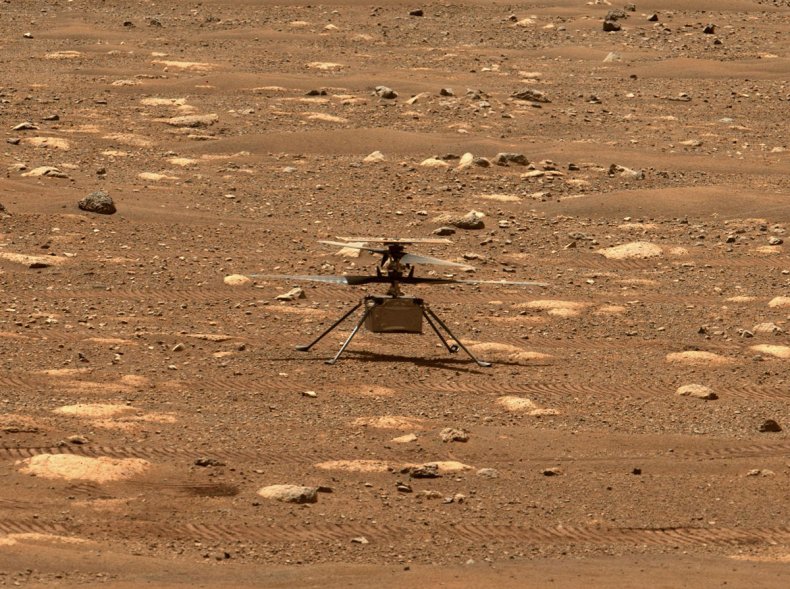What NASA's Mars Ingenuity Helicopter's First Flight Means for Future of Space Exploration
NASA's Ingenuity Mars helicopter made history on Monday, becoming the first vehicle to demonstrate controlled, powered flight on another planet.
But what are the implications of this achievement for the future of space exploration?
Michael Gaffey, a professor in the Space Studies Department at the University of North Dakota, told Newsweek that the successful flight opens up a whole new range of possibilities for exploring Mars.
"Mars landing missions have always had to aim at 'safe' areas—ideally flat featureless areas—to minimize the risk of encountering an obstacle, such as a large rock, that would damage or tumble the lander," Gaffey said.
"However, such 'safe' areas are generally scientifically boring relative to the science questions that can be addressed in areas of topography where rock layers—and geologic history—are exposed."
Some regions on Mars, such as the exposed layers in the walls of the up to six-mile-deep canyons of Valles Marineris, cannot be reached using a surface rover and could only be explored with a flying vehicle, according to Gaffey.
"In addition to exploring such topographically challenging geologic regions, a flying machine can cover a vastly greater distance from the landing site than can a rover, allowing a much broader survey and often multiple high priority sites from a single landing," he said.
The success of Ingenuity paves the way for future Mars missions to employ aerial survey techniques over large regions to identify high priority targets, he said. It also opens up the possibility that future missions could deliver sophisticated analytical instruments to remote and even otherwise inaccessible sites. These instruments could be used to investigate surface properties of the planet.
"For example, a helicopter could have touched down and sampled layers all the way to the summit of Mount Sharp (Aeolis Mons) in Gale crater exploring the billion or so years of the geologic and climate record exposed in the mountain, rather than just the lowermost—and oldest, albeit very important—layers studied by the Curiosity rover," Gaffey said.
"Envision a flying machine hoovering beside an exposed outcrop on a cliff face five kilometers above the floor of Valles Marineris or alongside the fresh ash deposits exposed on the caldera rims of one of the Tharsis volcanoes while the vehicle's instruments make measurements to reveal the history recorded in those deposits."
Jonathan Black, a professor with the Kevin T. Crofton Department of Aerospace and Ocean Engineering at Virginia Tech, told Newsweek that Ingenuity has demonstrated a "completely new mode of transportation" with the ability to cover more ground and explore farther than ever before.
Black described the implications of Ingenuity's first flight as "very important" for the future of autonomous air vehicles on Mars.
"Showing something is possible is the first step in making it routine," Black told Newsweek.
He said future aircraft like Ingenuity could be capable of carrying out a range of tasks, including transportation, surface mapping, communications, navigation, atmospheric data gathering and sample collection.
Christopher Edwards, an assistant professor in the the Mars Rover Lab (MRL) at Northern Arizona University, told Newsweek the successful flight is a "significant milestone" because it provides the first means to do local-scale reconnaissance, which is relevant for humans and robotic exploration of mars. For example, helicopter scouts could map out long drives before a rover heads off in that direction.
"So basically we can generate very high resolution maps that will allow robots and future human explorers to create safe traverses. Future helicopters are likely to involve additional instrumentation—not just cameras—which will help place future missions in the broader context as well," he said.
"With rover based missions you're often left wondering what is just around the next corner, and because you are constantly limited by rover resources—for example, power, etcetera—a mini-scout that can help guide decision making is going to be revolutionary."
In addition, proof of flight in the thin Martian atmosphere, which is only around one percent as dense as Earth's at the surface, validates the possibility of flight in other worlds beyond Earth and Mars, according to Gaffey.
"An obvious possibility would be Titan, the giant moon of Saturn," he said. "Titan has an atmosphere 50 percent thicker than the Earth's atmosphere."
"A flying machine could sample the hydrocarbon smog layers in its mostly nitrogen atmosphere, explore its methane lakes and river valleys cut into water ice bedrock by rainfall or snowmelt-fed methane rivers. A single flying enabled mission could do the job of a slew of surface landers."
In fact, Ingenuity's successful flight would prove the concept for NASA's planned Dragonfly mission, scheduled for launch in 2026, which is aiming to explore Titan with an eight-bladed rotorcraft.
However, because Titan's atmosphere is nearly the same thickness as earth—actually it is thicker—there are different challenges than flying on Mars.
Experts say that these helicopters will only become more and more capable over time, as their designs evolve.
"The small Sojourner rover that landed on Mars in 1997 was also a technology demonstration, but 20 years later resulted in having car-sized nuclear-powered rovers that could drive dozens of kilometers across the Martian surface," Mark Salvatore, another assistant professor from Northern Arizona University's MRL, told Newsweek.
"I can only imagine that 20-plus years from now, this sort of helicopter technology will also similarly improve in both size and capabilities."


